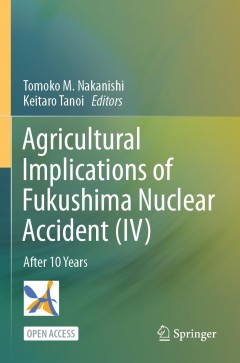Filter by

Vaccines for Neglected Pathogens: Strategies, Achievements and Challenges
This book reviews successes and (remaining) challenges in vaccine development for the selected Neglected Tropical Diseases (NTD) of Leprosy, Leishmaniasis, Meliodoisis and Tuberculosis, which are a continuous burden for millions of people in affected areas worldwide. Written by frontline researchers, the volume deep-dives into different vaccine strategies, provides biotechnological background i…
- Edition
- 1
- ISBN/ISSN
- 978-3-031-24355-4
- Collation
- VI, 344
- Series Title
- -
- Call Number
- -

Agricultural Implications of Fukushima Nuclear Accident (IV)
This open access book presents the findings from on-site research into radioactive cesium contamination in various agricultural systems affected by the Fukushima Daiichi Nuclear Power Plant accident in March 2011. This fourth volume in the series reports on studies undertaken at contaminated sites such as farmland and forests, focusing on soil, water, mountain, agricultural products, and animal…
- Edition
- 1
- ISBN/ISSN
- 978-981-19-9361-9
- Collation
- XIII, 276
- Series Title
- -
- Call Number
- -

Klimawandel in Deutschland
Dieses Open-Access-Buch beschreibt die Auswirkungen von Klimaveränderungen auf Wirtschaft und Gesellschaft in Deutschland. Es liefert eine fundierte, fachübergreifende Grundlage für Entscheidungen im Zusammenhang mit dem Klimawandel. Wie lassen sich die Folgen des Klimawandels abmildern und wie können wir uns vorbereiten? Die hier vorliegende nationale Untersuchung stellt den aktuellen F…
- Edition
- -
- ISBN/ISSN
- 9783662666968
- Collation
- XX, 527
- Series Title
- -
- Call Number
- -

Democratizing Risk Governance
This open access book features contributions from a multidisciplinary team of leading and emerging scholars focused on democratization of risk assessment, management, and communication. The volume identifies and sheds light on key risk governance dilemmas related to public trust, risk perception and public participation. The first part of the book articulates the relationship among science, exp…
- Edition
- -
- ISBN/ISSN
- 978-3-031-24271-7
- Collation
- XVIII, 421
- Series Title
- -
- Call Number
- -

Big Data and Artificial Intelligence in Digital Finance
This book has received funding from the European Union’s Horizon 2020 research and innovation programme under grant agreement No. 856632. Specifically, the chapters of the book present work and results achieved in the scope of the H2020 INFINITECH project. The editors acknowledge the contributions of all coauthors, as well as support from all INFINITECH project partners.
- Edition
- -
- ISBN/ISSN
- 9783030945909
- Collation
- XXIII, 363
- Series Title
- -
- Call Number
- -

iCity. Transformative Research for the Livable, Intelligent, and Sustainable …
Economy and society today face a multitude of complex challenges (“grand challenges”) like climate change, demographic change, urbanization, or digitalization, which create a constant demand for new technologies, services, business models, and consequently innovative solutions. In this light, the mobility sector has undergone a great change over the past few years, which is formed by di…
- Edition
- -
- ISBN/ISSN
- 9783030920968
- Collation
- XLI, 371
- Series Title
- -
- Call Number
- -

Photonic Neural Networks with Spatiotemporal Dynamics: Paradigms of Computing…
This open access book presents an overview of recent advances in photonic neural networks with spatiotemporal dynamics. The computing and implementation paradigms presented in this book are outcomes of interdisciplinary studies by collaborative researchers from the three fields of nonlinear mathematical science, information photonics, and integrated systems engineering. This book offers novel m…
- Edition
- -
- ISBN/ISSN
- 978-981-99-5072-0
- Collation
- VIII, 278
- Series Title
- -
- Call Number
- -

Reconstructions of Gender and Information Technology: Women Doing IT for Them…
This open access book explores what makes women decide to pursue a career in male-dominated fields such as information technology (IT). It reveals how women experience gendered stereotypes but also how they bypass, negotiate, and challenge such stereotypes, reconstructing gender-technology relations in the process. Using the example of Norway to illuminate this challenge in Western countries, t…
- Edition
- -
- ISBN/ISSN
- 9789819951871
- Collation
- XV, 133
- Series Title
- -
- Call Number
- -

Post-Communist Transformations in Baltic Countries: A Restorations Approach i…
This Open access book provides a survey of the economic, health, and somatic progress of Baltic countries during the period 1918–2018, framed by the outline of the historical-sociological theory of modern social restorations, as originally conceived by the Austrian-American comparative historian Robert A. Kann. The author reworks Kann's theory to analyse post-communist transformations in the …
- Edition
- -
- ISBN/ISSN
- 9783031394966
- Collation
- XVI, 291
- Series Title
- -
- Call Number
- -

Fortbildungen für KulturSchule: Wie Kulturelle Bildung in die Schule kommt
In diesem Open-Access-Buch gibt eine Evaluationsstudie Auskunft, wie teilnehmende Lehrkräfte Fortbildungen erleben, die auf die KulturSchul-Entwicklung zielen. Welche Perspektiven bauen diese auf? Und welche internen Unterstützungsmaßnahmen trifft die Schule, damit sich die Lernkultur ändern kann? Die Fortbildungsreihen im Landesprogramm «KulturSchule Hessen» legen die Grundlage daf�…
- Edition
- -
- ISBN/ISSN
- 9783658422219
- Collation
- XI, 243
- Series Title
- -
- Call Number
- -
 Computer Science, Information & General Works
Computer Science, Information & General Works  Philosophy & Psychology
Philosophy & Psychology  Religion
Religion  Social Sciences
Social Sciences  Language
Language  Pure Science
Pure Science  Applied Sciences
Applied Sciences  Art & Recreation
Art & Recreation  Literature
Literature  History & Geography
History & Geography